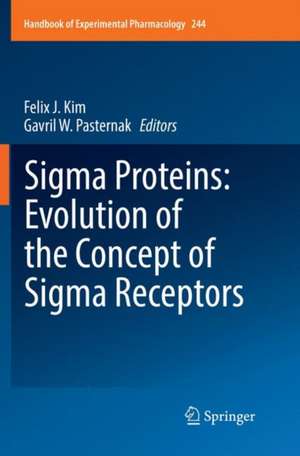Sigma Proteins: Evolution of the Concept of Sigma Receptors: Handbook of Experimental Pharmacology, cartea 244
Editat de Felix J. Kim, Gavril W. Pasternaken Limba Engleză Paperback – 15 aug 2018
| Toate formatele și edițiile | Preț | Express |
|---|---|---|
| Paperback (1) | 1543.65 lei 39-44 zile | |
| Springer International Publishing – 15 aug 2018 | 1543.65 lei 39-44 zile | |
| Hardback (1) | 2096.28 lei 6-8 săpt. | |
| Springer International Publishing – 13 oct 2017 | 2096.28 lei 6-8 săpt. |
Din seria Handbook of Experimental Pharmacology
- 5%
 Preț: 3517.78 lei
Preț: 3517.78 lei - 5%
 Preț: 1425.97 lei
Preț: 1425.97 lei - 5%
 Preț: 1435.28 lei
Preț: 1435.28 lei - 5%
 Preț: 1430.52 lei
Preț: 1430.52 lei - 5%
 Preț: 1930.69 lei
Preț: 1930.69 lei - 5%
 Preț: 1922.47 lei
Preț: 1922.47 lei - 5%
 Preț: 1937.46 lei
Preț: 1937.46 lei - 5%
 Preț: 2117.58 lei
Preț: 2117.58 lei - 5%
 Preț: 2119.96 lei
Preț: 2119.96 lei - 5%
 Preț: 2117.38 lei
Preț: 2117.38 lei - 5%
 Preț: 1088.17 lei
Preț: 1088.17 lei - 5%
 Preț: 1098.27 lei
Preț: 1098.27 lei - 5%
 Preț: 1420.29 lei
Preț: 1420.29 lei - 5%
 Preț: 1104.84 lei
Preț: 1104.84 lei - 5%
 Preț: 1104.84 lei
Preț: 1104.84 lei - 5%
 Preț: 1108.14 lei
Preț: 1108.14 lei - 5%
 Preț: 1106.69 lei
Preț: 1106.69 lei - 5%
 Preț: 1105.77 lei
Preț: 1105.77 lei - 5%
 Preț: 1174.35 lei
Preț: 1174.35 lei - 5%
 Preț: 1432.50 lei
Preț: 1432.50 lei - 5%
 Preț: 408.48 lei
Preț: 408.48 lei - 5%
 Preț: 409.63 lei
Preț: 409.63 lei - 5%
 Preț: 539.90 lei
Preț: 539.90 lei - 5%
 Preț: 720.47 lei
Preț: 720.47 lei - 5%
 Preț: 733.09 lei
Preț: 733.09 lei - 5%
 Preț: 731.27 lei
Preț: 731.27 lei - 5%
 Preț: 746.43 lei
Preț: 746.43 lei - 5%
 Preț: 747.72 lei
Preț: 747.72 lei - 5%
 Preț: 725.24 lei
Preț: 725.24 lei - 5%
 Preț: 742.80 lei
Preț: 742.80 lei - 5%
 Preț: 393.23 lei
Preț: 393.23 lei - 5%
 Preț: 735.66 lei
Preț: 735.66 lei - 5%
 Preț: 728.33 lei
Preț: 728.33 lei - 5%
 Preț: 389.52 lei
Preț: 389.52 lei - 5%
 Preț: 730.71 lei
Preț: 730.71 lei - 5%
 Preț: 740.58 lei
Preț: 740.58 lei - 5%
 Preț: 730.19 lei
Preț: 730.19 lei - 5%
 Preț: 723.42 lei
Preț: 723.42 lei - 5%
 Preț: 731.27 lei
Preț: 731.27 lei - 5%
 Preț: 726.68 lei
Preț: 726.68 lei - 5%
 Preț: 3516.49 lei
Preț: 3516.49 lei - 5%
 Preț: 729.26 lei
Preț: 729.26 lei - 5%
 Preț: 737.11 lei
Preț: 737.11 lei - 5%
 Preț: 730.92 lei
Preț: 730.92 lei - 5%
 Preț: 738.78 lei
Preț: 738.78 lei - 5%
 Preț: 909.94 lei
Preț: 909.94 lei - 5%
 Preț: 720.10 lei
Preț: 720.10 lei - 5%
 Preț: 734.74 lei
Preț: 734.74 lei - 5%
 Preț: 727.80 lei
Preț: 727.80 lei
Preț: 1543.65 lei
Preț vechi: 2031.12 lei
-24% Nou
Puncte Express: 2315
Preț estimativ în valută:
295.39€ • 315.86$ • 246.28£
295.39€ • 315.86$ • 246.28£
Carte tipărită la comandă
Livrare economică 14-19 aprilie
Preluare comenzi: 021 569.72.76
Specificații
ISBN-13: 9783319881164
ISBN-10: 3319881167
Pagini: 330
Ilustrații: VIII, 330 p. 64 illus., 32 illus. in color.
Dimensiuni: 155 x 235 mm
Ediția:Softcover reprint of the original 1st ed. 2017
Editura: Springer International Publishing
Colecția Springer
Seria Handbook of Experimental Pharmacology
Locul publicării:Cham, Switzerland
ISBN-10: 3319881167
Pagini: 330
Ilustrații: VIII, 330 p. 64 illus., 32 illus. in color.
Dimensiuni: 155 x 235 mm
Ediția:Softcover reprint of the original 1st ed. 2017
Editura: Springer International Publishing
Colecția Springer
Seria Handbook of Experimental Pharmacology
Locul publicării:Cham, Switzerland
Cuprins
Preface.- Historical perspective and background - including Sigma protein subtypes and ligand selectivity.- Sigma imaging agents.- Medicinal chemistry.- 3-dimensional homology models of Sigma1.- Neuronal plasticity and ion channels.- Opioid receptors and other GPCR.- Cancer.- Neurodegenerative diseases.- Pain.- Cognition, learning, neurological disorders.- Drug abuse and addiction.- Alcohol Abuse.- Stroke and neuroprotection.
Notă biografică
Felix J Kim PhD, Drexel University, College of Medicine, Pharmacology and Physiology,
Philadelphia, USA
Gavril Pasternak MD Ph., Memorial Sloan-Kettering Cancer Center, Anne Burnett Tandy Chair in Neurology, Molec Pharmacology and Chemistry, New York, USA
Caracteristici
Provides an updated perspective on this rapidly evolving field undergoing changes in fundamental concepts of key importance to the discipline of pharmacology Emphasis is laid on the roles of sigma proteins in pathophysiology and on emergent therapeutic initiatives New investigators combined with more experienced investigators - as represented by the editors
